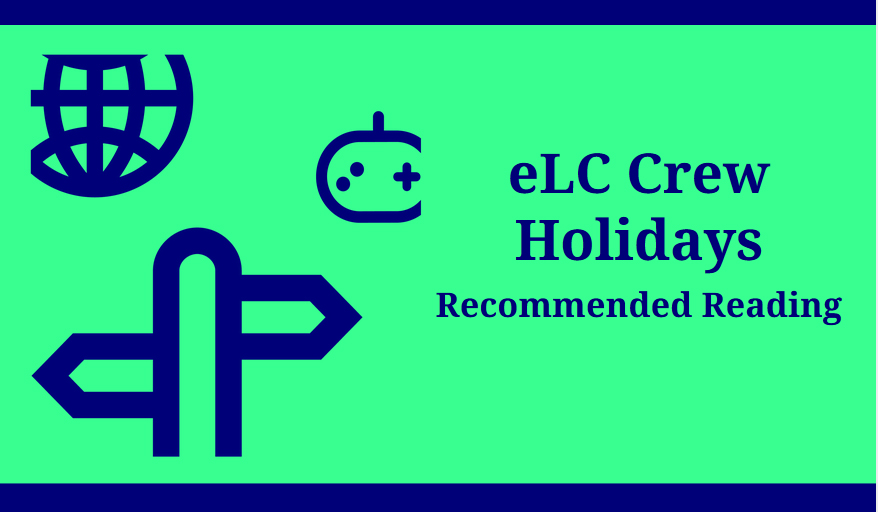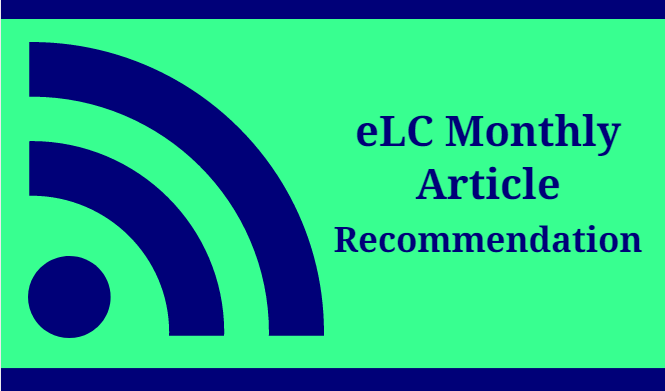2018 Summer eLC Crew Holidays’ Recommended Reading
27 July, 2018
We have worked hard this year and we all deserve time for rest and for fun and also… to recharge our energies and keep on moving the wheel of educational advances! To be well informed to enter the new course, the eLearn Center offers recommended reading to read about topics related to e-Learning, education and technology.
The selection contains different reading formats highlighting the following Learning related topics:
- • Educational policies and the future of HEIs
- • Open Educational Resources
- • Dropout in online HE
- • Blockchain in education
- • AI and Machine Learning in HE
- • Instructional Design
- • Ethical implications and moral dilemmas of the new technologies
We have also selected different formats including news, articles, reports and research papers to gather several points of view, offering an actual educational overview that can be useful to all, “connoisseurs and dilettantes” in the education’s field of knowledge. Enjoy summer reading the latest information about education and technology to enter the next course full of ideas!
*Don’t forget to click on the title to access the links to the sources.
- • Open Educational Resources
Education Dive
July 17, 2018
Study indicates free textbooks boost grades
A research at the University of Georgia, suggests that using OER (Open Educational Resources) is an equity strategy for higher education: providing all students with access to course materials on the first day of class serves to level the academic playing field in course settings. About half of the more than 20,000 students in the six-year study were given free digital textbooks for eight courses, including biology, history, psychology and sociology. Among students who used the open educational resources (OER), about 12% more received A grades and the number of students dropping out was about 3% less. The study has shown that students given free course material not only save money but get better grades, according to Inside Higher Education.
⇒The study “The Impact of Open Educational Resources on Various Student Success Metrics” (Colvard, Watson, Park 2018) is available here.
- • Dropout in Online Higher Education
EADTU Newsletter
July 2018
UOC research about Dropout in Online Higher Education
The UOC publishes a research about Dropout in Online Higher Education supported by the eLearn Center and the Generalitat de Catalunya under research grant 2014 SGR 1271.
One of online distance learning’s positive attributes is its flexibility. However, the possibility of engaging in periods of non-enrollment (breaks) usually ends in students dropping out. This paper by UOC experts Josep Grau-Valldosera, Julià Minguillón and Anabel Blasco-Moreno, analyzes the intention to continue of those students who have not enrolled in the second semester, adopting a long-term program perspective, and it is compared with the subsequent restart (or dropping out) in the third semester. This analysis has confirmed that the models of continuance intention and effective re-enrollment are essentially different: continuance intention is more rational, and is mainly based on the level of satisfaction or dissatisfaction with the educational experience while effective re-enrollment is more practical, with more importance given to the effects of student dimension variables such as the motivations for studying or environmental variables.
⇒The study “Returning after taking a break in online distance higher education: from intention to effective re-enrollment” (Grau-Valldosera, Minguillón, Blasco-Moreno 2018) is available here.
- • Educational Policies
EADTU Publications
2018
Latest edition of Changing Pedagogical Landscape (CPL) by EADTU
EADTU and its members have conducted a follow-up study on the first Changing Pedagogical Landscape report (published in 2015). Based on qualitative research in various European countries, this report identifies patterns in policies and practices of new models of teaching and learning. An increasing number of universities and colleges offer, next to degree programmes, continuous education and lifelong learning, and open education mainly related to OERS and MOOCs. In all three areas of provision, new pedagogies have emerged, strongly enabled by the innovation/ICT push and facilitated by different support structures at various levels. Universities start to develop visions and strategies to position themselves at the national and international level in each of these areas and need sufficient autonomy to determine their position in these three areas and to act flexibly and rapidly to respond to changes in society and economy. The report observes an accelerated uptake of digital education at various levels.
⇒The publication The Changing Pedagogical Landscape. In search of patterns in policies and practices of new modes of teaching and learning is available here.
- • e-Learning main topics in research indexed articles
UOC
May 2018
e-Learning Research Report 2017. Analysis of the main topics in research indexed articles
A report by the UOC’s e-Learn Center analysed the 855 pieces of scientific research published on this subject area during 2017 that had the greatest impact. The E-Learning Research Report 2017, analysed the publications of the two main scientific article databases, Scopus and Web of Science, and is the first to analyse all the articles on e-learning published worldwide during 2017 on an international level. According to the authors, Núria Molas-Castells and Marc Fuertes-Alpiste, until now there has been no overview allowing us to say which areas of e-learning worldwide research is focusing on. The report also makes a comparison with the subject areas research focused on throughout 2016. Concerning the educational stages focused on by the analysed study, the majority corresponded to degree courses (56.6%), followed by those in the professional context (12.6%) and, in third place, pre-university courses (8.5%).
⇒ The report is available here.
- • Blockchain in Education
Crypto Daily
January 15, 2018
4 Ways Blockchain Can Transform Education
Blockchain is the transaction verification technology utilised by digital currencies such as Ethereum and Bitcoin revolutionizing the financial sector, being an incorruptible ledger of all transactions that have taken place with any given cryptocurrency. But how can blockchain be applied to the education sector? A report from the EU’s Joint Research Centre (JRC) has highlighted another use for blockchain that has the potential to be a game-changer.
According to the JRC, there are four main advantages to the system:
- Eliminating the need for paper.
- The end of centralised education authorities.
- Saving money for educational institutions.
- The rise of education-specific cryptocurrencies.
⇒The publication JRC Science for Policy Report. Blockchain in Education (Grech, Camilleri 2017) is available here. The JRC report lays out some other specific scenarios attainable in the short, medium and long term. This includes automatic recognition and transfer of course credits, receiving payments like student fees or grant funding and using verified sovereign identities for student identification within organisations – when entering student accommodation or joining the university library, for example. The report is also reviewed in the piece of news Harnessing the potential of blockchain to transform education by the EU Science Hub (The European Commission’s science and knowledge service).
- • Machine Learning in Education
True Interaction
April 10, 2018
AI and the classroom. Machine Learning in education
A complete article by Michael Davison of True Interaction about Machine Learning in Education. As the contemporary classroom has become more and more digitized, recent advances in AI and Machine Learning do not only collect and analyze data that students generate when they interact with digital learning systems, but also gather large swaths of data from other areas including demographic data of students, educator demographic and performance data, admissions and registration info, human resources information, and so forth. This information can be used by educators, schools, and policy makers to predict the risk of a student to drop out of school, personalize student curricula, scheduling subjects, etc. The time is now for organizations, in education or otherwise, to research how a cost-efficient machine learning component can transform their operational output.
_
EDUCAUSE Review Podcast
February 26, 2018
The Intersection of Machine Learning and Higher Ed
Ray Blackwood, Vice President of Product Management at Campus Management talks in this podcast about the intersection of AI and Machine Learning in Higher Education, specifically, and how colleges can leverage both to improve their institutions and help students.
Overview of the Podcast
Colleges are asking for predictions and ML is not well used at all still as universities develop it but do not know how to accurately apply it yet. Campus Management has created a bot called Renee [1] which the student can add to his phone and it contacts and connects like a kind of “bot persona“. It would increase engagement. Regarding predictions from patterns, Blackwood says the accuracy comes from how long have we been tracking students as we need massive amounts of past data to predict the future. Microsoft has created interfaces to ease the process. There are no standards for storing and administrate the data. There is a great variety of data storage configuration and conversion problems. Having data in a specific format is a challenge. The aim for the future is that data will help to change people’s behavior and inspire them to become better citizens.
[1] Renee is the name of the artificial intelligence bot created by Campus Management, and it is being tested in several higher education institutes across the country. More info at: https://mytechdecisions.com/it-infrastructure/artificial-intelligence-higher-education-curriculum/
- • Artificial Intelligence in Education
McKinsey & Co.
April 2018
The role of education in AI (and vice versa)
There’s tremendous anxiety about workforce issues in AI and the paper it will play in education and in the job field. The field of education is searching for ways to respond to the fast-approaching impact of artificial intelligence (AI) across all sectors and areas, including its own. Princeton’s head of computer science, Jennifer Rexford, explains in this article how Artificial Intelligence is set to change how teachers teach and how this requires not only focusing on teaching different skills to prepare today’s youth for work in an AI world but also employing AI to adopt novel ways of teaching. She also talks about applying machine learning to the neuroscience data collected, or even to more mundane things such as logs of how many times students rewatch a portion of a video lecture or where they stumble or where they slow the reading down to watch it more closely. And it can also potentially help to personalize the students’ learning so that they can learn at a more efficient pace than they can in today’s one-size-fits-all classrooms.
–
- • Virtual Reality in Education
Essay Writing
2018
Virtual Reality Learning: A Technological Venture In Education (+ infographic)
Students, in particular, are eagerly waiting for the opportunity to experience new changes in the classroom. This article and infographic reviews how Virtual Reality has evolved in education and how it’s used as an effective learning tool in today’s classrooms. The Virtual Learning Environment is a combination of Virtual Reality and Augmented Reality, having primarily focused on cognitive development for students. The main areas of this development are language, numerical understanding, comprehensive improvement, strengthening concept development and classroom engagement. Traditional classrooms focus on textbook reading, an instructional method of study and less involvement while the virtual classroom helps to surround the students with simulated environments, objects and people, and encourages them to be part of the information and truly make their studies come to life. Virtual Learning helps, thus, to bridge the real and digital world.
Photo by Maarten van den Heuvel on Unsplash







